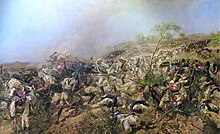Colony of Eritrea
The colony of Eritrea ( Italian Colonia Eritrea ) was an Italian colonial area in the Horn of Africa . It comprised what is now Eritrea and existed from 1890 to 1936. From 1936 to 1941 it was part of the Italian colony of Italian East Africa .
Acquisition
The explorer Giuseppe Sapeto acquired the first Italian areas on the Red Sea in the Bay of Assab . His company " Rubattino " bought in 1869 and in March 1870 a six-kilometer stretch of coast, which was then militarily protected as a trading post. After a conquest by Egypt at the end of April 1870 and the renewed purchase by the "Rubattino" company in March 1880, the Kingdom of Italy took over the port city of Assab and in July 1882 founded the colony of Assab .
Various Italian organizations made repeated voyages of discovery into the interior of Eritrea and then to Abyssinia . From 1885, other areas were gradually acquired. In 1885 Baylul , Massaua and the Dahlak Archipelago were conquered. After an Abyssinian attack on Italian troops in Dogali , the Italian government began to expand its influence over the entire region. Italian troops took Asmara in August 1889 and a year later introduced a new currency, the Eritrean tallero .
The colony
The areas around Massua, Assab and Asmara were united and on January 1, 1890 the colony of Eritrea was proclaimed. The first governor was Baldissera Orero . He encouraged the immigration of Italians, especially farmers. The Eritreans were exploited as cheap labor. New social classes emerged and the colony experienced an economic boom. The local population was expropriated and their rights severely restricted. Political opponents and rebels were fought under Baldiserra and from February 1892 by his successor Oreste Baratieri . Baratieri's authoritarian, military style of leadership, which was based among other things on a discriminatory racial policy, soon became offensive. That is why there was a revolt of the locals in 1894, which was bloodily suppressed. From Eritrea, after the battles of Coatit and Senafe in 1895 , Italy began its campaign of conquest against Abyssinia, which ended in a humiliating defeat for Italy in the Battle of Adua in 1896 .
Baratieri was then replaced by Antonio Baldissera, and in 1897 Ferdinando Martini became governor of Eritrea. Under Martini, a civil government was established instead of the previously existing military government and corruption was fought. In addition, the Italian administration expanded the infrastructure in the colony of Eritrea with hospitals and school buildings. The construction of railroads and roads as well as urbanization continued. Assab, in which a first-rate post office was established on January 22, 1885, was the main post office district of the colony. The economy was promoted with the Banca per l'Africa Orientale .
In 1936 there were mainly Muslims (around 57% of the population) and Christians (39%) living in Eritrea .
In 1935 Eritrea became a deployment base for the second Italian campaign of conquest against Abyssinia , the Italo-Ethiopian War . Now Eritrea has been incorporated as a province into the colony of Italian East Africa , a union of the colony of Italian Somaliland (including Oltre Giuba ) and occupied Ethiopia.
The economy was promoted, so companies such as the Birra Melotti brewery were founded.
In 1941, during World War II, Eritrea was conquered by British troops. This ended the Italian rule in Eritrea. In 1947, Italy agreed to the British UN mandate over Eritrea.
See also
literature
- Eyassu Gayim: The Eritrean Question. The conflict between the right to self-determination and the interests of State. Iustus, Uppsala 1993, ISBN 91-7678-240-9 ( Studies in international law 12), (also: Uppsala, Univ., Diss. 1992).
- Edward Ullendorff: The Ethiopians. An Introduction to Country and People. 2nd edition. Oxford University Press, London et al. 1965, p. 90.
Individual evidence
- ^ Alessandro Studio: Storia del colonialismo italiano: da Crispi a Mussolini . Datanews, Rome 2003, ISBN 88-7981-225-4 p. 38
- ↑ Stefano Poscia: Eritrea: colonia tradita . Edizioni associate, 1989 p. 19
- ^ Charles Henry Alexandrowicz: The European-African Confrontation: A Study in Treaty Making. Leiden 1973, p. 72ff.
- ↑ Small World Atlas of the German Book Association 1936, (page 161) (Meyers Enzyklopädisches Lexikon, Volume 8, page 119. Mannheim 1973/79).
- ^ Giampaolo Calchi Novati: Africa Orientale Italiana. In: Encyclopaedia Aethiopican, vol. 1 [AC], Wiesbaden 2003, pp. 129-133 / 134.


